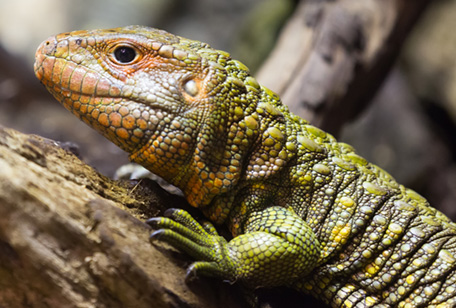
Dracaena guianensis
Northern regions of South America
Least Concern
What’s in a name?
Covered in large, bony scales, the skin of a Caiman lizard resembles that of an actual Caiman- a crocodilian species that also inhabits Central and South America. Like real caimans, caiman lizards are fantastic swimmers and spend a large portion of their time in the water. They even come equipped with a third, specialized eyelid that acts as goggles when they’re underwater.
While its appearance and semi-aquatic lifestyle may suggest that that the caiman lizard is related to these crocodilians, it is actually a cousin of the Tegu. It is just as well equipped for life on land and in the trees as it is for in the water.
Beaded teeth
Caiman lizards primarily eat snails, as well as mollusks, crabs, insects, and even the occasional amphibian or turtle! With a unique diet comes a unique set of teeth. Because their prey items are slow-moving, their teeth don’t have to be pointed to grip or hold their food in place. Instead, all of the caiman lizard’s teeth are rounded, almost like beads. These specialized teeth, coupled with powerful jaw muscles, allow them to crush the shells of their prey and eat the meatier bits inside!
To learn more, download the Northern Caiman Lizard fact sheet.
